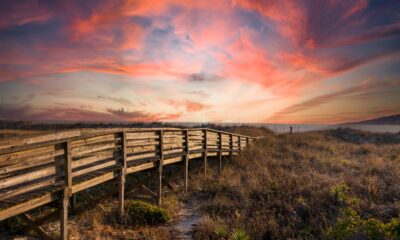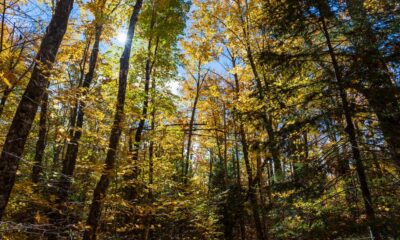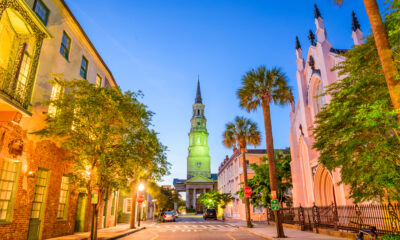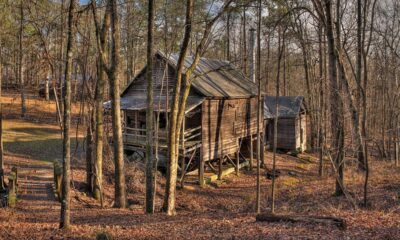California
Now-extinct Nicoleño tribe of Channel Islands: story of the last survivor
Published
2 months agoon

The Lone Woman of San Nicolas Island
Channel Islands National Park holds the story of America’s most isolated survival tale.
In 1811, Russian hunters slaughtered most of the Nicoleño men on San Nicolas Island, destroying a tribe that had lived there for 10,000 years.
By 1835, only twenty survivors remained when a rescue ship arrived to take them to mainland missions. But when storms hit, the panicked crew sailed away, leaving behind one woman.
She survived alone for eighteen years, crafting tools from whale bones and wearing cormorant feathers until Captain George Nidever found her in 1853.
This is her remarkable story of endurance and where you can explore the island that became her world.

Russian Hunters Killed Nicoleño Tribe in Bloody 1811 Raid
In 1811, a Russian-American Company ship called Il’mena landed on San Nicolas Island with 30 Aleut hunters from Alaska. They came looking for valuable sea otter pelts, known as “soft gold” back then.
The Aleut hunters attacked local Nicoleño men who tried to stop their women from being sexually assaulted. The fight turned into a bloodbath, with almost all adult male islanders killed during the year-long stay.
Spanish officials later arrested some Russian hunters, but the damage was done to this ancient tribe that had lived there for 10,000 years.

Tribe Numbers Dropped to Just Twenty Survivors
By 1835, only 18-20 Nicoleños remained alive on the island. This small group was mostly women and children, with an old man called Black Hawk among the few adult males left.
The island’s sea otters had been wiped out by too much hunting, taking away an important food source for the survivors. Catholic missionaries in Santa Barbara heard about their tough situation and wanted to help.
They planned to bring the remaining islanders to mainland missions.

Storm Forced Ship to Leave Without Checking Everyone
Captain Charles Hubbard sailed the schooner Peor es Nada (“Nothing is Worse”) to San Nicolas Island in November 1835. The American otter hunters’ boat was hired for this rescue mission by Mission Santa Barbara.
Nineteen tribal members gathered at the beach and got on the boat, ready to leave their home forever. As they got ready to go, the weather turned bad.
Winds picked up and the waves grew rough around the rocky shores, threatening to wreck the ship.

One Woman Stayed With Her Son
New evidence shows the woman wasn’t accidentally left behind but chose to stay with her adult son who refused to board the ship.
As the storm got worse, the scared crew left quickly without properly counting all passengers. Several rescue tries in the following years failed to reach the island or find the woman.
The Peor es Nada later sank in San Francisco Bay. The woman became the only person living on the 8,000-acre windy island, 60 miles from California.

She Built Homes From Whale Bones and Brush
The lone woman built round brush shelters about 6 feet across and 5 feet high, using whale bones to hold them up.
She also made smaller whale-bone huts with narrow openings where she kept cooking fires for warmth and food prep.
For food storage, she hung seal meat from tall poles 4-8 feet high, using ropes to keep her food safe and dry for winter.
She cleverly made a water collection system using heated stones and natural tar to make waterproof containers.

Hunting Skills Kept Her Fed for Nearly Two Decades
At night, the woman hunted seals using stone weapons and harpoon tips she had hidden around the island. She made fishing hooks from abalone shells and fishing lines from seal guts.
She caught cormorants, ducks, and other seabirds using methods she learned as a child. She wove four different basket shapes for various uses and created bone needles for sewing clothing and making tools.
These skills kept her alive year after year in complete loneliness.

Shark Attack Killed Her Son and Left Her Completely Alone
The woman lived with her adult son for several years on the island.
Tragedy struck when he died in a brutal attack by a shark or killer whale while fishing from his canoe offshore. This loss left her completely alone for the next decade on the isolated island.
Despite having no family or hope of seeing other people again, she kept up her daily survival routines, taking care of her shelters and food stores across the island.

Cormorant Feather Dresses Showed Her Creativity
From cormorant skins, the woman sewed a dress with colorful feathers in detailed patterns.
She made a belt from sinew and created personal items using bird bones, seal hide, and plant fibers she found on the island.
Though her hair became matted and bleached by the sun over the years, she took care of her appearance as best she could with limited supplies.
Throughout her time alone, she kept her cultural knowledge alive by singing traditional songs and practicing tribal customs.

Footprints in the Sand Led to Her Discovery in 1853
Fur trapper George Nidever found human footprints and seal blubber drying on the beach during his third trip to the island in 1853.
His crew member Carl Dittman spotted the woman hiding in brush near three whalebone huts built in a sand dune clearing.
When they came close, she showed no fear and offered the visitors food, showing her survival skills and hidden supply stashes.
The crew spent a month learning her daily routines while hunting seals and gathering resources from around the island.

Santa Barbara Welcomed the "Wild Woman" as a Celebrity
The woman willingly boarded Nidever’s ship, bringing only her cormorant feather dress and water basket.
Her arrival in Santa Barbara caused a sensation, with curious visitors coming from miles around to see the “wild woman” from the remote island.
She couldn’t communicate with local Chumash, Tongva, or other California Indian interpreters because her language was unique.
She lived with the Nidever family, entertaining guests with songs and dances while trying to adapt to mainland life after 18 years of solitude.

Last Speaker of an Ancient Language Dies After Just Seven Weeks
The woman got sick with dysentery and hurt herself in a fall soon after arriving in Santa Barbara. Her health quickly got worse despite care from the Nidever family.
Father González Rubio baptized her with the name “Juana Maria” shortly before she died on October 19, 1853. With her death, the Nicoleño language vanished forever, taking 10,000 years of tribal knowledge with it.
She was buried in an unmarked grave at Mission Santa Barbara cemetery, though a commemorative plaque was placed there in 1928 to honor her remarkable story.

Visiting Channel Islands National Park
You can learn about the last Nicoleño woman’s story at Channel Islands National Park’s visitor center at 1901 Spinnaker Drive in Ventura Harbor.
Admission and parking are free, and it’s open daily 8:30 AM to 5 PM. Watch the 25-minute film “Treasure in the Sea” narrated by Kevin Costner throughout the day.
Weekend ranger programs at 11 AM and 3 PM cover park history. Check out the viewing tower with telescopes and live tidepool displays.
This article was created with AI assistance and human editing.
Read more from this brand:
John Ghost is a professional writer and SEO director. He graduated from Arizona State University with a BA in English (Writing, Rhetorics, and Literacies). As he prepares for graduate school to become an English professor, he writes weird fiction, plays his guitars, and enjoys spending time with his wife and daughters. He lives in the Valley of the Sun. Learn more about John on Muck Rack.


Here Are 12 Things People from West Virginia Do That Seem Insane To Everyone Else

Here Are 12 Things People from Washington Do That Seem Insane To Everyone Else

Here Are 12 Things People from Virginia Do That Seem Insane To Everyone Else

New Mexico Albuquerque International Balloon Fiesta wrap-ups and fall arts

Mississippi Natchez Trace fall festivals and music events

12 Reasons Why You Should Never Ever Move to Florida

Best national parks for a quiet September visit

In 1907, Congress forced Roosevelt to put God back on U.S. coins. Here’s why.

The radioactive secret White Sands kept from New Mexicans for 30 years

America’s most famous railroad photo erased 12,000 Chinese workers from history
Trending Posts

 Pennsylvania3 days ago
Pennsylvania3 days agoHere Are 12 Things People from Pennsylvania Do That Seem Insane To Everyone Else

 North Carolina4 days ago
North Carolina4 days agoHere Are 12 Things People from North Carolina Do That Seem Insane To Everyone Else

 Nebraska6 days ago
Nebraska6 days agoHere Are 12 Things People from Nebraska Do That Seem Insane To Everyone Else

 Maine5 days ago
Maine5 days agoThe ruins of a town that time forgot are resting in this Maine state park

 New York4 days ago
New York4 days agoHere Are 12 Things People from New York Do That Seem Insane To Everyone Else

 South Carolina2 days ago
South Carolina2 days agoHere Are 12 Things People from South Carolina Do That Seem Insane To Everyone Else

 Ohio4 days ago
Ohio4 days agoHere Are 12 Things People from Ohio Do That Seem Insane To Everyone Else

 Georgia5 days ago
Georgia5 days agoThis plantation’s slave quarters tell Georgia’s slowest freedom story
